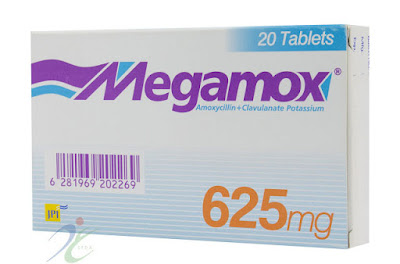Megamox Tablets & Syrup | (Indications, contraindications, side effects and dosage)
Megamox comes in different forms like tablets and syrup. Megamox tablets also have different strengths from 125 mg to 1000 mg / 1g. In this post we will cover them all. We will tell you the usage of megamox tablets, side effects, contraindications, and dosage information and everything you need to know before taking this medicine.
 |
| Megamox 625 mg tablets packing / box |
Indications / Usage of Megamox:
For use Megamox as monotherapy and in combination with clavulanic acid: an infectious-inflammatory diseases caused by susceptible microorganisms, including bronchitis, pneumonia, tonsillitis, pyelonephritis, urethritis, infections of the gastrointestinal tract, gynecological infections, infections of the skin and soft tissue, listeria, leptospirosis, gonorrhea.
For use Megamox in combination with metronidazole: chronic gastritis in acute, peptic ulcer and duodenal ulcer in acute, associated with Helicobacter Pylori.
Megamox used in the following cases:
- Upper respiratory tract infection
- Lower respiratory tract infections
- Skin and soft tissue infections
- Urinary and genital tract infections
- Women infections
- Dental infections
Megamox Medicine Composition:
Megamox tablets are composed of chemicals like Amoxicillin and Clavulanic Acid. The strength of the ingredients varies from medicine to medicine. Like tablets comes in different strengths as do the syrups. You can easily read the ingredient strength information on packing box or on the back of strip containg tablets.- Amoxicillin:
It is a derivative of penicillin, has a wide range of bactericidal activity against a number of both Gram-positive and Gram-negative bacteria.- Clavulanic Acid :
Clavulanic acid and its salts and esters. The acid is a suicide inhibitor of bacterial beta-lactamase enzymes from Streptomyces clavuligerus. Administered alone, it has only weak antibacterial activity against most organisms, but given in combination with beta-lactam antibiotics prevents antibiotic inactivation by microbial lactamase.Amoxicillin acid Clavulanic with strong efficacy against a broad range of bacteria, Gram-positive and Gram-negative bacteria, including bacteria producing the enzyme beta Aktames as well as various anaerobes.
Dosage and method of use:
The effectiveness of amoxicillin and Clavulanic Acid is not affected by food and therefore can be used before or after meals.Adults and children over 12 years
Mild to moderate infections:One tablet of 375 mg every 8 hours
Severe infections:
One tablet 1000 mg every 12 hours or one tablet of 625 mg every 8 hours.
Children less than 3 months of age:
30 mg / kg of body weight per day divided every 12 hours.Children over 3 months of age:
20-40 mg / kg of body weight per day divided every 8 hours.Contraindications Megamox:
Patients with hypersensitivity to penicillin and / or Claveulenk acid.Side effects of Megamox:
Usually the body bears Megamox well but in case of overdose some symptoms can occur like nausea, vomiting, abdominal pain, or a rash.Megamox During Pregnancy and Lactation:
In studies conducted on animals given doses higher than the usual human dose and showed the result that they did not had any adverse effects on the fetus have not been conducting studies on humans therefore can only be prescribed if necessary by a doctor.Pharmacological form of Megamox:
Megamox is available in different quantities:Megamox 156 mg / 5 ml suspension syrup
Megamox 312 mg / 5 ml suspension syrup
Megamox 228 mg / 5 ml suspension syrup
Megamox 375 mg tablets
Megamox 625 mg tablets
Megamox 1 g tablets.
CAUTION: Too dangerous to take any medication without the advice of a qualified physician.




Comments
Post a Comment